Description, properties and cultivation of white willow

A description of the white willow, its properties and cultivation is very important for those who want to decorate the territory - after all, this is one of the most beautiful and, moreover, unobtrusive-looking trees. Wanting to surprise everyone with your knowledge, you can say what the tree is called in Latin, and what is the difference between Green Bell, Chermezina and other varieties. But in practice, it is more important to know the value of willow willow in landscape design, the features of its planting, caring for it, and the order of reproduction.
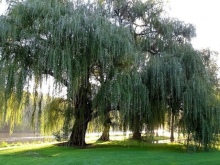
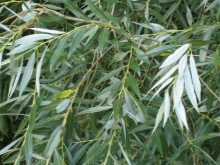

Description of the tree
When they say white willow, they mean the same tree, which is sometimes called willow. In nature, it populates all of Europe, with the exception of the extreme northern points, the Asia Minor region. It was also "noted" in Kazakhstan and even in Iran. The area is significantly expanded due to artificial distribution. Together with the settlers, the white willow also came to North America.
Nevertheless, this tree is considered typical for the middle part of Russia. Note that it lives well even in urban conditions, despite the gas pollution and other unfavorable factors. Reproduction is possible by seeds, however, they differ only in a short germination period, which makes such work difficult. The height reaches 20-30 m.
After felling, the tree can actually be transformed into a shrub.
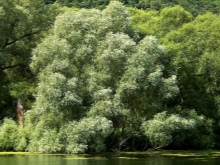
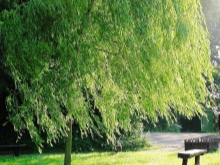

White willow looks very elegant. It is characterized by a tent-like or wide roundness of the crown, often taking a weeping shape. Because of this, they often even talk in everyday life about the weeping willow. Young shoots are olive green or reddish-brown in color. Older shoots are distinguished by the absence of fragility, exposure and yellowish-red-brown color.
The foliage belongs to the alternate type, has a lanceolate or narrowed lanceolate shape. The top of the leaves is pointed. The length varies from 50 to 150 mm. In this case, the width ranges from 10 to 30 mm. The flowers are grouped into earrings 30-50 mm long, distinguished by their impressive thickness. In Latin this tree is called Salix alba L.
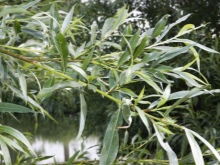
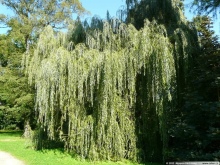
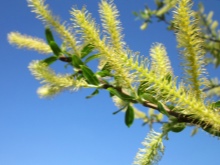
When they talk about the silvery willow, they mean the same plant. The trunk girth is up to 3 m. The diameter of the crown is simply enormous - sometimes it coincides with the total height of the willow. Even such impressive dimensions do not interfere with the use of this species in landscape design and other applications. Willow has an impressive lifespan, 100-year-old trees are completely ordinary.
With the onset of autumn, the foliage turns yellow, but it falls late enough. At the beginning of summer, seed pods appear in place of the earrings. Branches appear in the lower parts of the trunk - significantly lower than in other trees. You can meet willow on floodplains, on the banks of the river, and near dwellings. In many places it forms groves that stretch along rivers for kilometers.
The root system of the plant is also very specific: the dominant root is absent, but the lateral roots develop very well. The power of the root complex is inversely proportional to the degree of soil moisture.
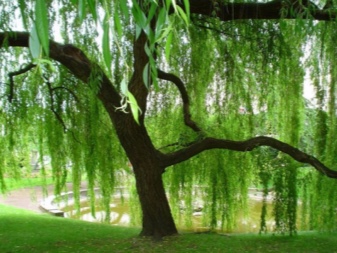

Subspecies and ornamental garden forms
Along with the weeping willow described above, its pyramidal variety definitely deserves attention. It is distinguished by its narrow leaves growing vertically upward. The formation of flowers is synchronized with the formation of foliage. The bark is yellow, with a pronounced brown tint. There are cracks in it, but they are not deep.At the top of the crown, the leaves are light green, but at the bottom of the trunk they are whitish.
The yolk columnar willow also deserves every attention. Yellow-red shoots are typical for her. The plant looks very attractive in the winter months, when the gardens are devoid of bright colors.
Unlike most other willows, it is not a weeping species. On the contrary, branches from the trunk depart at an acute angle.
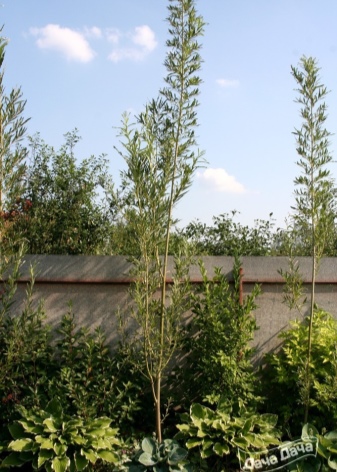
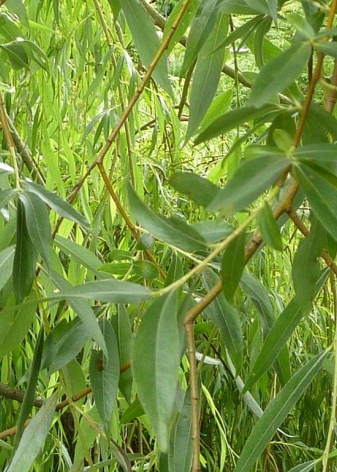
It is worth mentioning about the winding shape of the tree. It differs from traditional wild counterparts in its bizarre form of shoots. The thicker they get, the more they straighten. But this process does not end, and therefore the originality of the species remains for a long time. The Tristis form reaches a height of 15-20 m.
Numerous shoots hang from its spreading crowns. The bark at the very beginning of development is slightly yellow, then it acquires a pronounced brown color. Shoots remain yellow throughout their life. The plant is light-requiring and can grow in dry places, but develops better in wet conditions. Flowering either coincides with the formation of leaves, or occurs immediately after it.
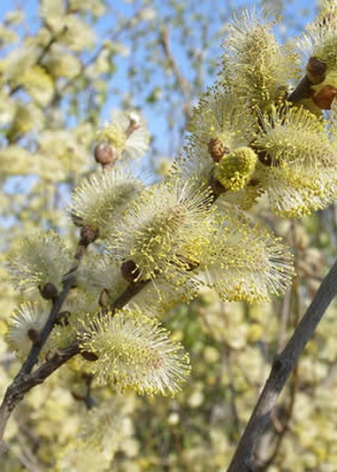
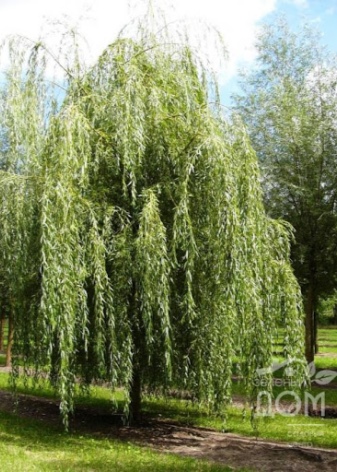
"Chermezina" can be both a tree and a large shrub. The usual height of mature plants ranges from 7 to 10 m. Individual specimens 15 m high have been recorded. The shape of a willow is an oval or an egg. The shoots are red with a pronounced yellow or orange tint.
The leaves are gray-green in color. The plant needs intense lighting. Against the background of drought, he needs active watering. Soil fertility is not too important, however, cultivation on deep loose loam is encouraged. Salinization of the land has an extremely negative effect on "Chermezin". But it is distinguished by its impressive resistance to frost.
A very good neighbor for her is the Green Bell plant from the cabbage family.
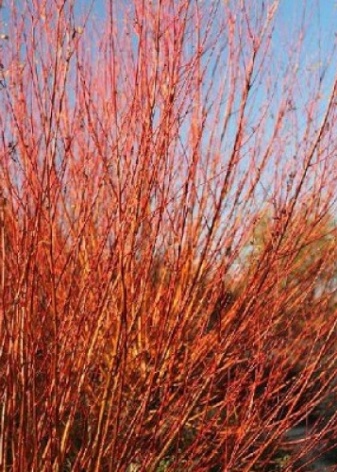
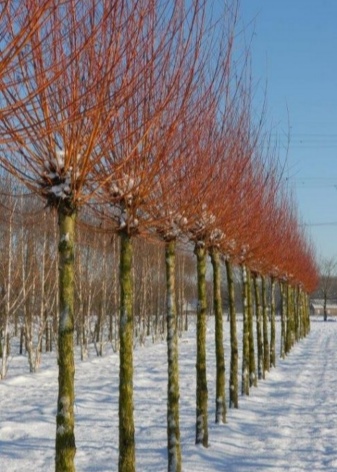
Growing conditions
Landing
White willow is distinguished by a reverent attitude towards light. No, it sometimes grows in moderately shady areas - but there you cannot count on the disclosure of its aesthetic qualities.
It is worth noting that this plant is also demanding on soil moisture. It is recommended to plant it in waterlogged, swampy areas, and the most harmonious points are the banks of rivers, ponds and lakes.
Willows are practically not afraid of floods - except for the risk of mechanical damage or toxic substances. You can confidently plant a willow on crushed stone, which is not distinguished by fertility. With a closed root system, planting is successfully carried out from April to the end of September. But it must be borne in mind that even this unpretentious culture can suffer from early frosts or the return of cold weather.
The section of the planting pit for the shrub willow is 0.5 m. If a tall tree is planted, the size is increased to 0.6 m. The depth does not depend on this and will be equal to 0.4 m. Solid sifted sand is poured onto the bottom. This is especially true on heavy soil, if necessary, the sand is replaced with crushed stone.
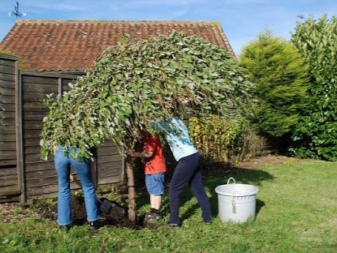

The willow substrate is prepared by mixing the following components:
- compost;
- peat;
- soil in equal proportions.
A third of the hole is filled with the substrate and the seedling is immediately buried there. The soil around the seat is compacted. Water the planting immediately. If a tall plant is planted, then you need to use a stake. Otherwise, if not tied up, the willow may die from its own weight at first.
Cuttings should be kept warm before planting. A warm room is ideal. But a greenhouse or greenhouse will work too.
It is hardly wise, however, to rush to land on open ground. It is more correct to wait until the plants get stronger and develop.
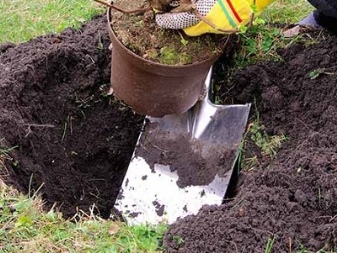
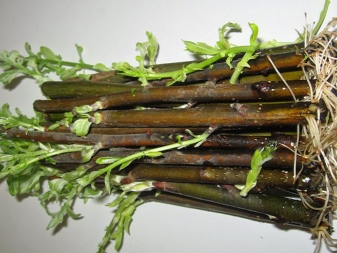
Care
Given the extreme need for moisture, willows need to be watered regularly and actively. This is done weekly in the morning or evening. If dry time comes, watering is carried out more often, sometimes every 2 or 3 days. But this only applies to truly extreme droughts.A young willow needs to be loosened onto a shovel handle.
Good growth is ensured by peat mulching. The mulch layer is 50-70 mm. If the development of a tree or bush has slowed down, top dressing is needed. For 1 plant, 0.06-0.08 kg of nitroammophoska is used.
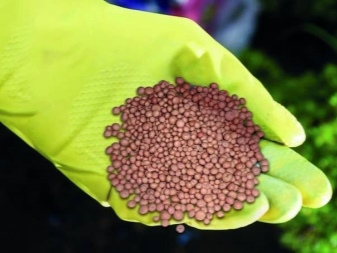
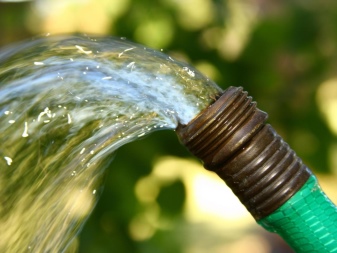
Important: you should make sure that poor growth is due to nutritional problems, and not to pests and diseases.
The main danger is posed by:
- willow leaf roll;
- aphid;
- flower fly.
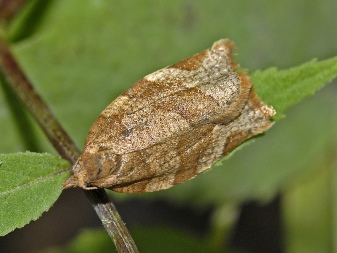
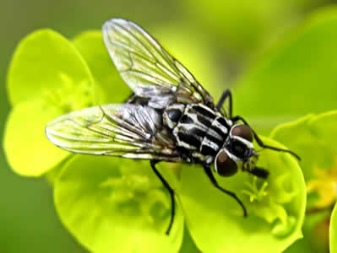
The leafworm is destroyed by collecting them by hand, as well as fighting clutches. A harmful fly is defeated with the help of "Karbofos" or more modern drugs. He, as well as "Actellik" are recommended for the fight against aphids. Treatment for diseases is carried out using:
- Fundazola;
- Topsina;
- Fundazima.
In the spring and summer, fertilizing with complex fertilizers is introduced. With the approach of autumn, the need for phosphorus and potassium increases. Top dressing is applied after slightly loosening the soil. As soon as the deciduous season begins, it is required to remove the fallen leaves. Violation of this requirement leads to infection with diseases.
In drought, plants can be helped by spraying the crown (but this procedure does not cancel watering, but supplements it).
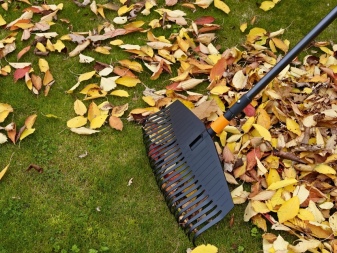

Formation
White willow is usually shaped like a bole. Any buds below 2 m will have to be removed. Others located above this mark are removed evenly. If the common tree skeleton is formed correctly, further complicated pruning will not be required.
Attention: removing dangerously growing large branches is the prerogative of professionals, because it is a very demanding job. Inoculations of additional branches are treated with garden varnish for greater protection.
Close to the reservoir, it is necessary to achieve a clear, pronounced vertical. This is that infrequent garden contrast that is perceived positively by all observers. Arches can be formed from weeping willows using a tall trunk. Celebrate the elegance of their combination with:
- thuja;
- cypress;
- juniper trees.

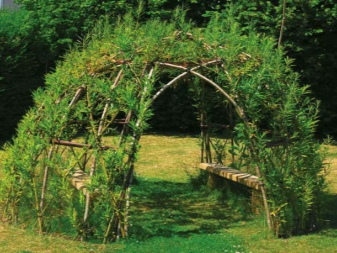
Reproduction
Most often, the plant propagates by cuttings. The requirements applied to it depend primarily on the height reached by the variety. White willow is grown from cuttings of at least 0.25 m in size. Some varieties require the use of layering or grafting of planting material onto a stem. Seed propagation is extremely ineffective, and it is mainly breeders who are engaged in it.
You can take both young and woody cuttings. The latter are even better rooting. When it passes, the plant quickly adapts and grows rapidly.
Cuttings are harvested either in autumn or in the first third of spring. Summer cuttings are ineffective. They take strictly the middle of the branch, from which they cut off several shoots developing since last year.
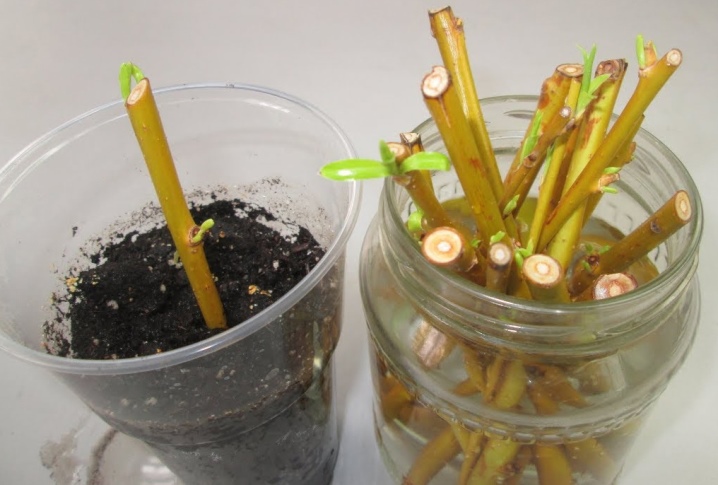
The cut off shoots are divided into cuttings of 150-250 mm. Carefully monitor that there are 2 or more buds at their tops. The use of thick cuttings is recommended. The cut material is planted, orienting the lower end down and the upper end, respectively, up. About 50% of the cuttings are immersed in the soil, but make sure that at least 1 bud is above it.
After planting, the plant is immediately watered. They achieve soil moisture so that it sticks to the surface of the shoot. After the leaves bloom, the willow is immediately shaded. Rooting begins in about 6-7 days. Solid roots can develop as early as 2-3 weeks.
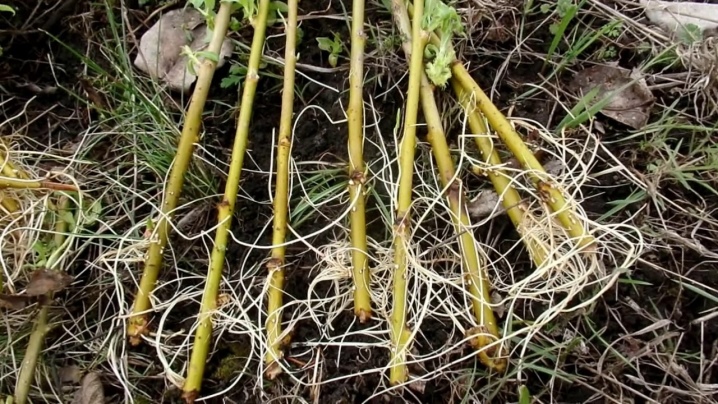
Application in landscape design
Planting a willow on a site usually means giving it a somewhat chaotic look. It must seem that the whole composition was composed with a slight carelessness. Willow trees are perfectly combined with birches, especially since these plants do not create mutual interference. It is quite logical to plant a weeping culture near a summer cottage. High-quality decorative varieties will even decorate small country ponds.
Sprawling willow crowns fit perfectly into rockeries and rock gardens. To make everything look better, you should add a white stone there and use bright plants as an accent. You can surround willow with decorative conifers and juicy flowers. Green hedges are formed from trees. To get a small fence, shrubs are used.
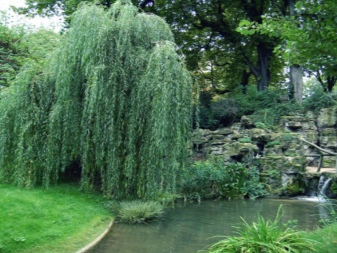
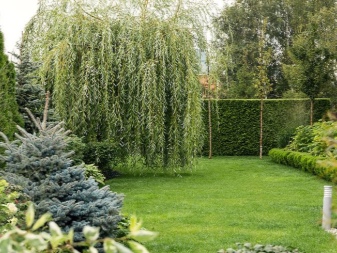
White willow is beautiful both in a single planting and as part of a landscape composition. It gracefully complements the English-style plots. In this case, asymmetry and free planning are welcome. The largest trees are planted in large areas. Tall plants are used in city parks and along highways.
Single landings in an open area are not very correct. The large size of the willow means its high windage. In strong winds, even the toughest specimens can break. But dense group plantings are also impractical - willows need a lot of space.
The best solution is to plant in rows or on a slope where the roots of the tree will stabilize the ground.
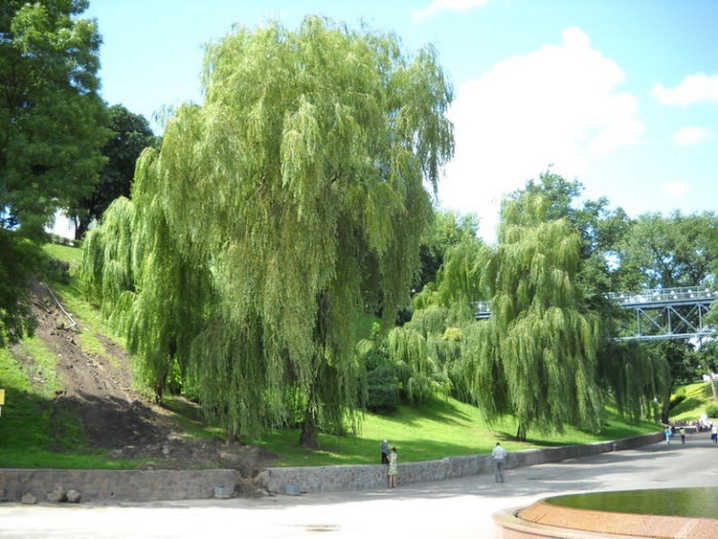



































































The comment was sent successfully.